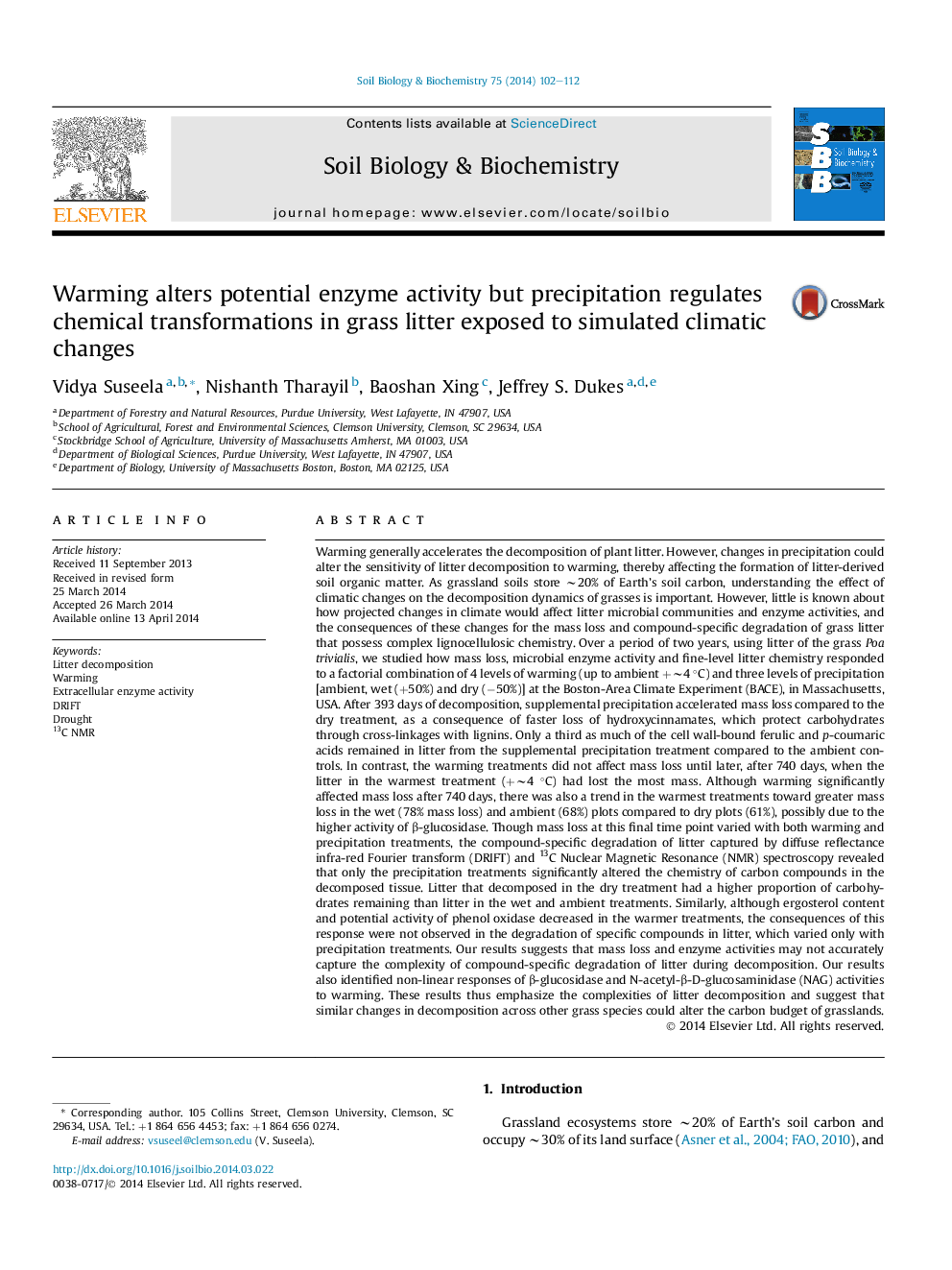| کد مقاله | کد نشریه | سال انتشار | مقاله انگلیسی | نسخه تمام متن |
|---|---|---|---|---|
| 8364711 | 1542609 | 2014 | 11 صفحه PDF | دانلود رایگان |
عنوان انگلیسی مقاله ISI
Warming alters potential enzyme activity but precipitation regulates chemical transformations in grass litter exposed to simulated climatic changes
ترجمه فارسی عنوان
گرما باعث تغییر فعالیت آنزیم بالقوه می شود، اما تغییرات شیمیایی در بسترهای علفی تحت تاثیر تغییرات آب و هوایی شبیه سازی قرار می گیرد
دانلود مقاله + سفارش ترجمه
دانلود مقاله ISI انگلیسی
رایگان برای ایرانیان
کلمات کلیدی
موضوعات مرتبط
علوم زیستی و بیوفناوری
علوم کشاورزی و بیولوژیک
دانش خاک شناسی
چکیده انگلیسی
Warming generally accelerates the decomposition of plant litter. However, changes in precipitation could alter the sensitivity of litter decomposition to warming, thereby affecting the formation of litter-derived soil organic matter. As grassland soils store â¼20% of Earth's soil carbon, understanding the effect of climatic changes on the decomposition dynamics of grasses is important. However, little is known about how projected changes in climate would affect litter microbial communities and enzyme activities, and the consequences of these changes for the mass loss and compound-specific degradation of grass litter that possess complex lignocellulosic chemistry. Over a period of two years, using litter of the grass Poa trivialis, we studied how mass loss, microbial enzyme activity and fine-level litter chemistry responded to a factorial combination of 4 levels of warming (up to ambient +â¼4 °C) and three levels of precipitation [ambient, wet (+50%) and dry (â50%)] at the Boston-Area Climate Experiment (BACE), in Massachusetts, USA. After 393 days of decomposition, supplemental precipitation accelerated mass loss compared to the dry treatment, as a consequence of faster loss of hydroxycinnamates, which protect carbohydrates through cross-linkages with lignins. Only a third as much of the cell wall-bound ferulic and p-coumaric acids remained in litter from the supplemental precipitation treatment compared to the ambient controls. In contrast, the warming treatments did not affect mass loss until later, after 740 days, when the litter in the warmest treatment (+â¼4 °C) had lost the most mass. Although warming significantly affected mass loss after 740 days, there was also a trend in the warmest treatments toward greater mass loss in the wet (78% mass loss) and ambient (68%) plots compared to dry plots (61%), possibly due to the higher activity of β-glucosidase. Though mass loss at this final time point varied with both warming and precipitation treatments, the compound-specific degradation of litter captured by diffuse reflectance infra-red Fourier transform (DRIFT) and 13C Nuclear Magnetic Resonance (NMR) spectroscopy revealed that only the precipitation treatments significantly altered the chemistry of carbon compounds in the decomposed tissue. Litter that decomposed in the dry treatment had a higher proportion of carbohydrates remaining than litter in the wet and ambient treatments. Similarly, although ergosterol content and potential activity of phenol oxidase decreased in the warmer treatments, the consequences of this response were not observed in the degradation of specific compounds in litter, which varied only with precipitation treatments. Our results suggests that mass loss and enzyme activities may not accurately capture the complexity of compound-specific degradation of litter during decomposition. Our results also identified non-linear responses of β-glucosidase and N-acetyl-β-D-glucosaminidase (NAG) activities to warming. These results thus emphasize the complexities of litter decomposition and suggest that similar changes in decomposition across other grass species could alter the carbon budget of grasslands.
ناشر
Database: Elsevier - ScienceDirect (ساینس دایرکت)
Journal: Soil Biology and Biochemistry - Volume 75, August 2014, Pages 102-112
Journal: Soil Biology and Biochemistry - Volume 75, August 2014, Pages 102-112
نویسندگان
Vidya Suseela, Nishanth Tharayil, Baoshan Xing, Jeffrey S. Dukes,
